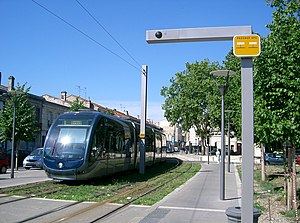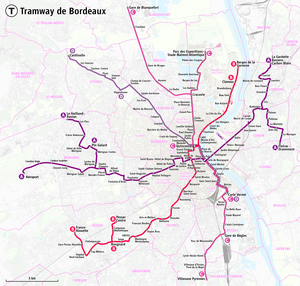Tramway de Bordeaux
 |
|||
| Overview | |||
|---|---|---|---|
| Native name | Tramway de Bordeaux | ||
| Locale | Bordeaux, Aquitaine, France | ||
| Transit type | Light rail tram | ||
| Number of lines | 3 (1 under construction) |
||
| Number of stations | 116 | ||
| Daily ridership | 282,000 | ||
| Annual ridership | 80,000,000 (2016) | ||
| Website | InfoTBM (English) | ||
| Operation | |||
| Began operation | 2003 | ||
| Operator(s) | TBM | ||
| Number of vehicles | 105 | ||
| Technical | |||
| System length | 66.1 km (41.1 mi) | ||
| Track gauge | 1,435 mm (4 ft 8 1⁄2 in) standard gauge | ||
| Electrification | 750 V DC ground-level power supply (APS) (city centre) 750 V DC overhead line (outside city centre) |
||
|
|||
The Bordeaux tramway network (French: Tramway de Bordeaux) consists of three lines serving the city of Bordeaux in Aquitaine in southwestern France.
The first line of Bordeaux's modern tramway opened on 21 December 2003; further extensions have increased the route length to 66.1 kilometres (41.1 mi). The system is notable for using a ground-level power supply of the Alimentation par Sol (APS) system in the city centre. It has been operated by Keolis Bordeaux since 1 May 2009.
The first tramway line of Bordeaux, with cars towed by horses, dates back to 1880. In 1946, the public transportation system in Bordeaux had 38 tram lines with a total length of 200 kilometres (120 mi), carrying 160,000 passengers per day. A rudimentary system of ground-level power supply was used on some stretches with mixed success. As in other French cities at the time the mayor, Jacques Chaban-Delmas (first elected in 1947), embraced anti-tram arguments and decided to terminate the operation of the tramway. He found the tramway to be old-fashioned compared to the bus and its attachment to set tracks on the ground hindered the increasing flow of cars. The lines were closed one after the other. In 1958 the last line of tramway was terminated.
By the 1970s the failure of the "all car" transport policy had become obvious, but Chaban was not prepared to backtrack. A grandiose automatic light underground railway (VAL) scheme was promoted; it even received the backing of a majority of the city's councillors, but fell victim in the end not just to the fierce opposition of the local transport users' association TRANSCUB but to the hard reality of the fine sandy nature of the city's soil. The VAL idea was dropped. Chaban remained.
Bordeaux had to wait until 1995 and the election of Alain Juppé as mayor – as well as the total strangulation of the city by its transport problems – before the situation was tackled. Following two years of studies, the Bordeaux Urban Community adopted the tramway plan in 1997. Recognized by the central government in 2000 as a Public Interest Project, the scheme got under way and by 21 December 2003 was carrying passengers on three routes, one of which was extended on 25 September 2005, with further extensions opened in 2007 and 2008.
...
Wikipedia

